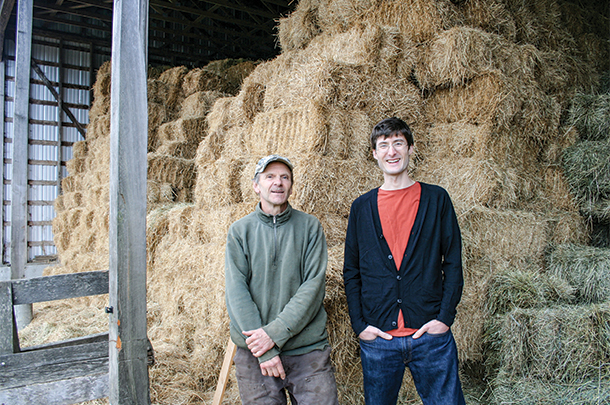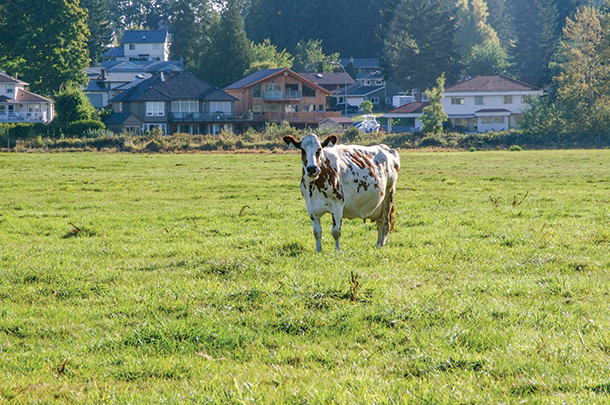Vancouver Island’s Comox Valley is not known to be a major dairy hub, but those familiar with the area will know it is full of small-town charm, artisan goods and businesses catering to the tourists who flock year-round to experience the laid-back lifestyle and bounty of recreational pursuits the region offers.
It is perhaps in the spirit of the region’s distinctiveness that the perfect conditions arose for a partnership between veteran dairy producer Guy Sim and relatively new to the industry yogurt makers and husband and wife duo Merissa Myles and Scott DiGuistini.
Forming a partnership
Sim has been in the dairy business for a long time. Since taking over his farm from his parents in 1970, he has had a front-row seat to the many industry changes and evolving trends in milk production. As farming practices fall in and out of fashion and production efficiency is challenged, Sim’s dairy, located in Comox on British Columbia’s Vancouver Island, has stayed steady. Throughout his time at the helm of Birkdale Farm, Sim has raised grass-fed Ayrshires.
It was because of these characteristics that working with Sim’s herd was so appealing to Myles and DiGuistini.
The couple first got the idea to start their Courtenay, British Columbia-based company, Tree Island Yogurt, after the 2010 eruption of the Icelandic volcano, Eyjafjallajökull, left them stranded in France where they had been traveling for DiGuistini’s work.
Myles and DiGuistini, who has a Ph.D. in biochemistry and microbiology with a focus on fungal genetics, had always dreamed of owning a family business, particularly one that focused on health-conscious products and would allow them to apply their creative aptitudes. While eating yogurt in France, they were inspired by the country’s emphasis on terroir and holistic approach to developing foods. After some planning and trialing, the couple began shipping yogurt to grocers in nearby Victoria in 2013 and have since expanded to stockists as far as Toronto.
With a business plan in place, Myles and DiGuistini toured dairy farms across Vancouver Island in search of milk to help them produce a unique product. “We wanted to create unique products because I didn’t think the world needed another straight strawberry yogurt,” says Myles. She says they are proud to produce yogurt without the use of powdered milk and to offer a product that maintains traceability to Vancouver Island.
 Originally established in 1836 in England, Birkdale Farm relocated to Vancouver Island’s Comox Valley in 1920. Photo provided by Merissa Myles.
Originally established in 1836 in England, Birkdale Farm relocated to Vancouver Island’s Comox Valley in 1920. Photo provided by Merissa Myles.While touring nearby Birkdale Farm, DiGuistini and Sim immediately hit it off, connecting over their mutual interest in genetics. “[DiGuistini and Sim] would talk about different choices around genetics, and Guy is a real herdsman, so he’s raised – in his third-generation family business – his herd over his whole lifetime and it is quite a show; it’s really something to be proud of,” Myles recalls. She says the connection between her husband and Sim made the decision to source milk from Sim’s cows through the BC Milk Marketing Board easy.
 Guy Sim (left) and Scott DiGuistini (right) connected over their interest in genetics which ultimately led to Sim supplying milk to DiGuistini’s yogurt processing business. Photo provided by Merissa Myles.
Guy Sim (left) and Scott DiGuistini (right) connected over their interest in genetics which ultimately led to Sim supplying milk to DiGuistini’s yogurt processing business. Photo provided by Merissa Myles.Building the Birkdale herd
The Sim family switched to Ayrshires in the 1950s after Sim’s parents had problems with seasonal drops in butterfat production from their Jersey herd. Sim says the Ayrshire breed is better suited to grazing, and he likes their hardiness and smaller frame, which makes them easier to handle.
Today, his herd produces an average of 26 to 27 litres of milk per day, with fat production levels at 5%.
 Despite the need to be hyper-conscious of his practices and land management, Guy Sim says his proximity to residential areas results in many positive encounters with neighbours who enjoy seeing his herd grazing. Photo provided by Merissa Myles.
Despite the need to be hyper-conscious of his practices and land management, Guy Sim says his proximity to residential areas results in many positive encounters with neighbours who enjoy seeing his herd grazing. Photo provided by Merissa Myles.As the owner and manager of Birkdale Farm, Sim has worked to improve his herd and refine their suitability for grazing and a grass-fed diet. Sim breeds for a functional cow with good feet, legs and udder, as well as strong milk components. Although it is not always easy, he strives to source genetics from outcrossed bloodlines whenever possible.
Sim describes the animals found in his herd today, “I’m developing more of an intermediate-sized cow because, with grazing, you want something with a good body – capacity-wise – because they’re dependent more on roughage.”
To achieve his breeding goals, Sim, a 2003 Master Breeder winner, relies on a few different tools. “I depend on all the bull proofs. I use genomics to some extent, but it’s not the be-all-and-end-all; I use it as a tool. I try to do corrective mating, which means watching how good a bull’s breeding pattern is,” he says. Sim says his hesitancy to commit more fully to genomics is due to the challenge it presents in determining breeding patterns, as the true success of breeding decisions are not seen until the daughter is ready to be milked.
Sim also uses classification to identify his herd’s strengths and weakness and has sent some bulls into A.I. with varying degrees of success.
He recognizes the ever-evolving state of dairy genetics and encourages others looking to improve their herd to visit farms with top genetics and always remain open to learning from others in the industry, especially those with good breeding individuals and a successful herd.
What it means to choose grass-fed
Myles and DiGuistini were drawn to the grass-fed component of Sim’s operation as their research revealed grass-fed milk offered the best milk composition, especially with regards to the levels of omega 3’s, compared with conventional or organic milk. “We also discovered Guy’s Ayrshire cows have a richer, different composition than Holstein cows. This means the milk has some natural homogenization and the fat doesn’t completely go to the top, which gives it a nice texture,” Myles says.
Twelve years into her journey as a yogurt processor, Myles recognizes education is still needed to help consumers understand the realities of grass-fed milk production in Canada. “I think a big thing about grass-fed is recognizing grass-fed in California is different than grass-fed in British Columbia,” she explains. “That is a really important thing to recognize. Due to our climate and everything, cows need to spend time indoors; they don’t want to be outside in the rain, and it’s not good for the field. Defining what that means is important. It is important for consumers to have more knowledge about how farms maintain cow health and land health.”
For Sim, the location of his dairy means the implications of grazing and raising a grass-fed herd are heightened. He describes his farm’s location as a “fishbowl.” It is surrounded by residential areas on three sides and the fourth side borders a forest which, like his own farm, is governed under an agricultural land reserve.
Sim says his location forces him to be hyper-conscious of his practices and land management. He notes that the needs and concerns of his neighbours must be considered before going ahead with practices like spreading manure on his land. However, he says letting his cows out on pasture brings joy and a sense of nostalgia to many of his neighbours.
Challenges with sourcing grain and the high cost of growing corn silage on Vancouver Island also continue to influence Birkdale Farm’s preference for producing grass-fed milk.
“I mean, you can go for extra production, but how much does it cost you? You must look at the health of the animals. The more you push them for production, the more likely it is their health may be compromised a bit. But the key is trying to produce a good balanced ration, if you’re dependent on grass, but you’re using some grain; you’ve got to try and be sure your grain is going to help balance things out in the ration,” he says.
The benefits of working together
As she reflects on the success of Tree Island Yogurt, which is in the process of tripling its production facilities and exploring the potential of expanding their product line, Myles says despite the ongoing challenges to source enough local, grass-fed milk to meet their needs, working with Sim has been a great perk.
“Guy loves those cows; I think all farmers do, but it is a real pleasure to be able to connect with a farmer when this is his lifeblood. I think that is one thing that isn’t communicated all the time in the media, but farmers are people [who] love what they’re doing and it’s a fantastic part of life,” Myles says.








